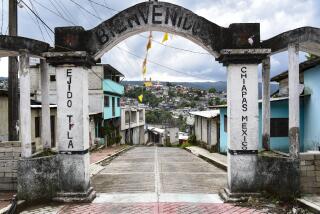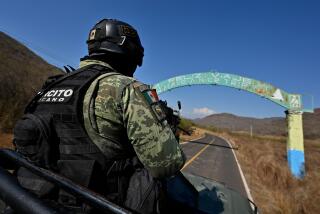Rebels, High Taxes, Falling Prices Bring Hard Times to Peru’s Miners : Andes: Four hundred mines, a third of the country’s mining operations, have closed in recent years, unable to cope with growing burdens.
MOROCOCHA, Peru — Andres Machacuoy and Alejandro Villavesa steady the powerful ore drill against the tunnel wall, scooping out a shower of rock particles that sparkle in the beams of their helmet-mounted flashlights.
Despite the deafening roar of the drill and the clouds of dust in the rarefied atmosphere of this vast copper mine 14,500 feet up in the Andes, they don’t wear earplugs or face protection.
Like Machacuoy and Villavesa, thousands of miners eke out a harsh existence digging copper, zinc, silver and gold along Peru’s mineral-rich Andean spine.
Once one of the world’s largest mineral producers, Peru has endured a production plunge in recent decades due to inept administration, recession and guerrilla war.
Four hundred mines, a third of the country’s mining operations, have closed in recent years, unable to cope with the additional burden of low international prices and high taxation.
“The truth is we’re all broke. We’ve only survived by going heavily into debt,” says Carlos Diez Canseco of the National Mining Assn.
A major burden has been security costs to ward off attacks by radical Shining Path guerrillas, who steal dynamite and blackmail mine owners.
The rebels have launched more than 300 attacks on mines since 1980, one study shows. An attack on Morococha in 1989 paralyzed the mine for a year.
Mining historically has been the pivot of Peru’s economy. Mineral exports bring in $2 billion a year, nearly half total exports.
But hard times have made it impossible even for Peru’s largest mining companies, such as Morococha’s owner Centromin, to provide decent work or living conditions for its workers.
In Morococha, 75 miles east of Lima, Juan Torres rests on his bed while his wife boils cabbage for lunch on their tiny kerosene stove. Outside, a hailstorm rattles the tin roof of their single-room shack.
Four-year-old Jesus, the youngest of Torres’ eight children, plays on the dusty wooden floor. An outdated calendar is the only splash of color against the smoke-blackened brick walls.
The family’s drinking water comes from a single tap next to reeking latrines in the muddy street outside.
“We’ve been exploited. It’s a slow death working down there,” says Torres, 45. “But I’m working for a better future for my kids.”
After 23 years with the company, he earns the equivalent of $7 a day.
Morococha is also the site of one of Latin America’s biggest ecological disasters.
Yellow-green lakes are fed by streams of untreated mineral waste flowing past miners’ homes. The mountains that rear over Morococha have turned a dirty orange color from the oxides that ooze from a honeycomb of tunnels.
Contamination is everywhere, from the high mercury levels in the drinking water to the copper particles pumped into the air by the refinery in La Oroya, a town 10 miles away.
These conditions have bred a range of illnesses.
Miners and their families commonly suffer from lung, skin and eye diseases, stomach ailments and high blood pressure. Few miners live past 50.
Morococha’s poorly stocked, understaffed hospital is overwhelmed by an average of 40 patients a day. Centromin recently sold its hospitals to Peru’s chaotic social security system to reduce costs.
“This place has gone downhill. Before we had surgeons who could operate in case of an accident,” says Dr. Wilber Alcantara, the hospital’s director. “Now we have to send patients by road to the hospital in La Oroya and hope they survive the trip. Often they don’t.”
The rough weather conditions in the Andes--freezing temperatures, hail and snow--further aggravate health problems.
On a recent visit by reporters to the mine, a heavy snowstorm blanketed the area within minutes.
“Here, even the Devil uses a poncho,” Centromin official Oscar Barreto says, shivering.
Although a plan to privatize Peru’s largest mines hopes to turn the situation around, the future for miners looks bleak in the short term.
Centromin, Peru’s biggest mining outfit, has laid off 7,000 miners in the last year in a bid to stem losses and streamline the company to make it attractive for privatization. The move enabled the company to break even last year after losing $150 million in 1991.
But hardships have bred ingenuity among the miners.
To solve their needs, the workers’ union has set up a communal soup kitchen, food market, hair salon and shoemaker’s shop.
“The company gives us only one pair of boots a year,” says shoemaker Fidel Castro, whose left-leaning father named him after the Cuban leader. “This way we can be self-sufficient.”
More to Read
Sign up for Essential California
The most important California stories and recommendations in your inbox every morning.
You may occasionally receive promotional content from the Los Angeles Times.










